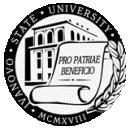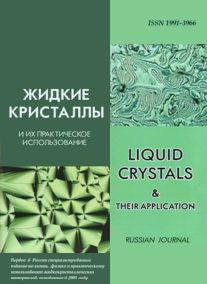|

|
Liquid Crystals and their Application
Russian Journal Zhidkie kristally i ikh prakticheskoe ispol'zovanie Жидкие кристаллы и их практическое использование |

|
|

|

|
|
|
Menu

|
|
|
|
|
Zhidk. krist. ikh prakt. ispol'z. = Liq. Cryst. and their Appl., 2017, 17 (4), 106—109.
DOI: 10.18083/LCAppl.2017.4.106 |

|
|
Photoconductivity of Nonaqueous Liposomes: a New Method of Measuring Temperatures of Structural Phase Transitions of Phospholipid Membranes
|
S. V. Yablonskii1, V. V. Bodnarchuk1, V. V. Grebenev1, S. I. Mikhailov2
|
Author affiliations
1Shubnikov Institute of Crystallography of Federal Scientific Research Centre «Crystallography and Photonics»
of RAS,
59 Leninsky Pr., Moscow, 119333, Russia
E-mail: yablonskii2005@yandex.ru
2Lebedev Physical Institute, Russian Academy of Sciences,
53 Leninsky Pr., Moscow, 119991, Russia
|
|
Abstract
A new method for measuring the temperatures of structural phase transitions in artificial phospholipid membranes is developed. The method is based on the investigation of the temperature dependence of the photoconductivity effect in a symmetric cell with current-conducting indium-tin oxide (ITO) electrodes. Phospholipids dissolved in complex alcohols or in water were placed into cells of the «sandwich» type. In the experiment, lyotropic phases of dipalmitoylphosphatidylcholine (DPPC) with ethylene glycol (EG) and glycerol (G) were studied. The photoelectric current in the measuring cell with a constant bias (1,6–31 V) was excited by injecting electrons from the electrode (ITO) into the mixture combinations. Mixtures of DPPC + EG (G) were prepared in a weight ratio of 1:1. Various sources of pulsed radiation were used for photoelectric excitation, working both in the near IR and in the visible wavelength range. As a result, the temperature dependences of the photoelectric current with singularities in the region of the main phase transition were obtained. The position of the features on the temperature scale corresponded to the temperatures of the main phase transition: T = 45 ± 1 °C (DPPC + EG, 1:1) and T = 42.5 ± 1 °C (DPPC + G, 1:1). In this paper, for the first time, a «posistor» effect of a weakly conducting liquid was detected. It is noteworthy that a small amount of the substance of the order of 0.1 mg was required to measure the temperature of the phase transition. The proposed method makes it possible to detect phase transitions in lyotropic liquid-crystal systems and, consequently, can be used to create biocompatible carriers of drugs based on thermosensitive liposomes.
Keywords: liposomes, phospholipids, lyotropic liquid crystals, photoconductivity, conductometry, phase transitions
|
|
|
|
|
|




